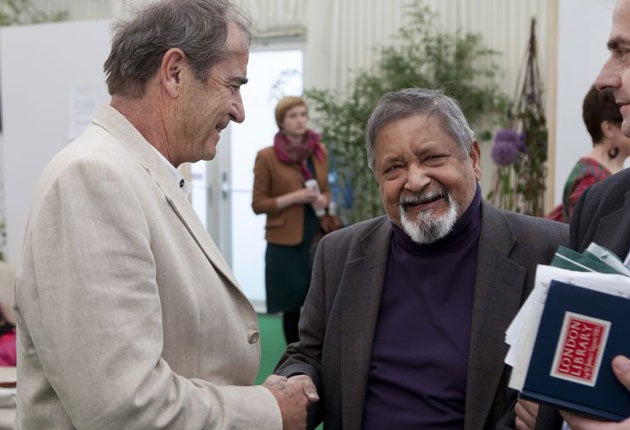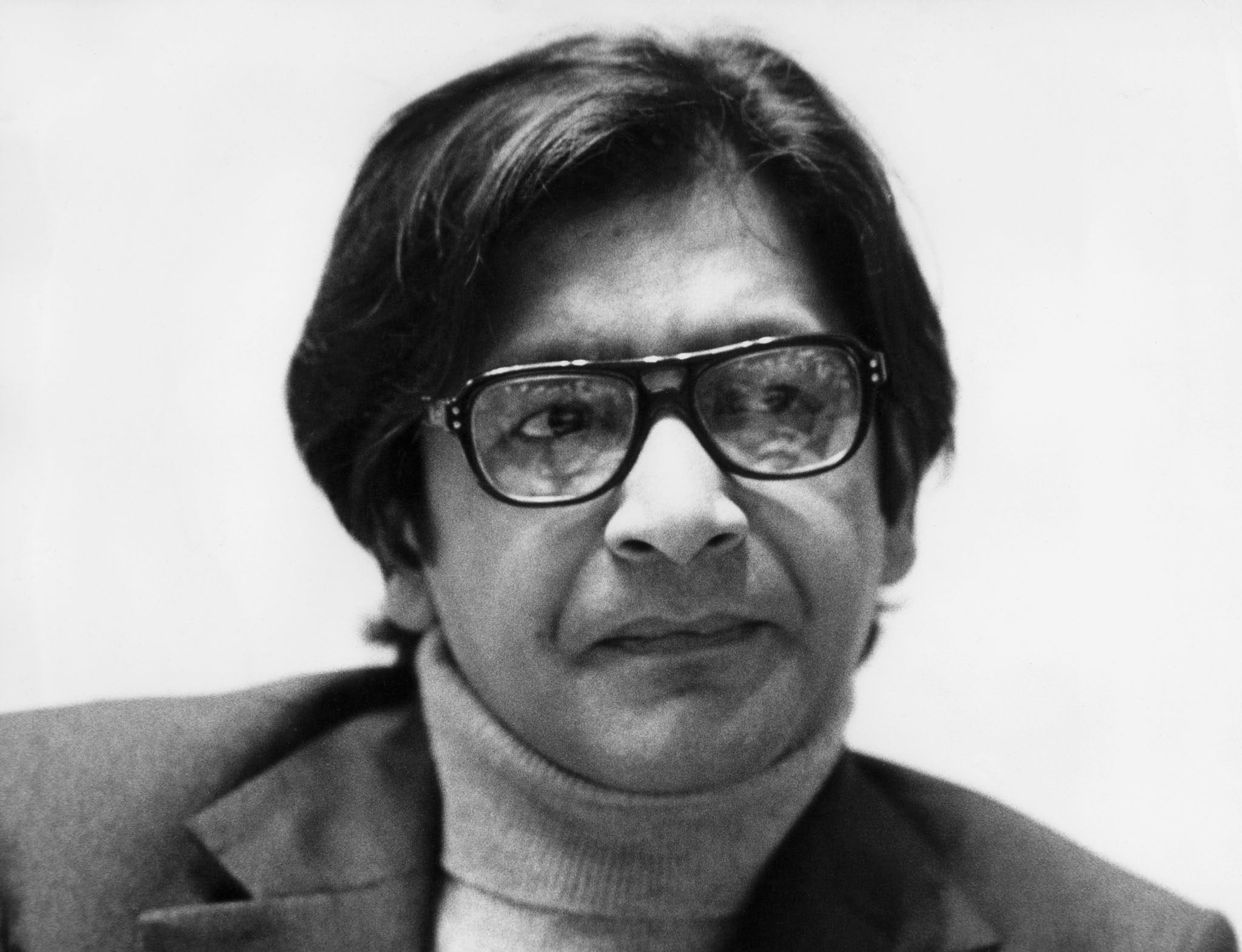VS Naipaul: Nobel prize-winning master of prose who attracted praise and scorn in equal measure
Accused of racism, misogyny and Islamophobia, Naipaul’s views put him at loggerheads with peers such as Edward Said, Salman Rushdie, Derek Walcott and Paul Theroux

Your support helps us to tell the story
From reproductive rights to climate change to Big Tech, The Independent is on the ground when the story is developing. Whether it's investigating the financials of Elon Musk's pro-Trump PAC or producing our latest documentary, 'The A Word', which shines a light on the American women fighting for reproductive rights, we know how important it is to parse out the facts from the messaging.
At such a critical moment in US history, we need reporters on the ground. Your donation allows us to keep sending journalists to speak to both sides of the story.
The Independent is trusted by Americans across the entire political spectrum. And unlike many other quality news outlets, we choose not to lock Americans out of our reporting and analysis with paywalls. We believe quality journalism should be available to everyone, paid for by those who can afford it.
Your support makes all the difference.In the second half of the 20th century, few writers were as praised or scorned as VS Naipaul, the Nobel-prize winning writer whose talent for styling prose was as great as his penchant for controversy. “If a writer doesn’t generate hostility,” Naipaul once said, “he is dead.”
Born in Trinidad in the early 1930s, he penned comic masterpieces of island life before turning to the larger world, travelling from South America to Africa and Asia for richly detailed works on countries freed from colonial rule. He died at his home in London on Saturday. He was 85.
Knighted in 1990, Naipaul faced accusations of racism, sexism, chauvinism and Islamophobia. He had long-running literary spats with Paul Theroux, a former protégé who lambasted Naipaul as “a grouch, a skinflint, tantrum-prone”, and the poet Derek Walcott, his Caribbean peer who depicted Naipaul in a poem as “a rodent in old age”.
Naipaul acknowledged frequenting prostitutes while married, physically abusing his mistress and treating his wife in such a way, he told biographer Patrick French, that “She suffered. It could be said that I had killed her.” Through it all, he expressed few regrets and maintained a prodigious output, publishing more than two dozen volumes that ranged from novels to travelogues to genre-bending works that mixed fiction with personal history.

His books – such as realist novels A House for Mr Biswas (1961), A Bend in the River (1979) and the Man Booker prize-winning In a Free State (1971) – were considered works of a technical virtuoso, whom even Walcott hailed as “our finest writer of the English sentence”. With few exceptions, his sentences were knife-sharp, devoid of fuss or flair but often lyrical in their simplicity.
Naipaul wrote Biswas, the book that vaulted him to acclaim, when he was in his 20s, after moving to England on a scholarship to the University of Oxford.
The book’s central figure, Mohun Biswas, was based loosely on Naipaul’s father, a journalist with literary aspirations. “Six-fingered, and born in the wrong way”, Biswas seeks a home of his own, and the sense of security and personal freedom that property might offer.
The story “was Dickensian in its scope and sympathy, yet wholly original”, cultural critic and screenwriter Stephen Schiff wrote in The New Yorker in 1994, with dozens of characters and settings that extended from the crowded streets of Trinidad’s capital to quiet sugar-cane plantations.
Like Naipau’s three previous books, including his 1959 story collection Miguel Street, it mixed tragicomic moments – endless fights between Biswas and his in-laws – and scenes that seemed to capture the author’s private longing for stability and satisfaction.
In one passage, Naipaul described the title character’s lingering memory of a late-afternoon bus ride:
In the gloom, a boy was leaning against the hut, his hands behind him, staring at the road.
He wore a vest and nothing more. The vest glowed white. In an instant the bus went by, noisy in the dark, through bush and level sugar-cane fields. Biswas could not remember where the hut stood, but the picture remained: a boy leaning against an earth house that had no reason for being there, under the dark falling sky, a boy who didn’t know where the road, and that bus, went.
Naipaul was initially known as a gentle chronicler of West Indian life, seen by some critics as part of a group that included Trinidadian writer Sam Selvon, the Barbadian novelist George Lamming and Walcott, who was from Saint Lucia.
After Biswas, however, Naipaul rarely wrote about his country with any warmth. Trinidad, Naipaul wrote in the 1962 travelogue The Middle Passage, was “unimportant, uncreative, cynical,” home to “a society which produced nothing, never had to prove its worth, and was never called upon to be efficient.”
Naipaul later said that the book, named for a stage of the slave trade in which Africans were taken in bondage to the Americas, was “terribly flawed” and overly harsh in its criticism of Trinidad and its Caribbean neighbours.
Still, it was a critical success, and engendered a succession of travels and travelogues. He visited India for three books, beginning with An Area of Darkness (1964), and travelled to the majority-Muslim countries of Iran, Pakistan, Malaysia and Indonesia for Among the Believers (1981) and Beyond Belief (1998).
His travel writings were often anatomies of catastrophe, profiles of communities that Naipaul described as “half-made” or decaying, and peppered with disdain for the former colonisers and the recently decolonised

To some critics, Naipaul offered what New Yorker writer Jane Kramer called “a topography of the void”, perceptive criticism of imperialism and oppression. To others, his work had a racist tinge. The literary critic Edward Said described Naipaul as “a purveyor of stereotypes and disgust for the world that produced him”, and called out in particular his depiction of Islam as a rage-filled, imperialistic faith.
Naipaul did little to comfort his critics. “Africans need to be kicked,” he once said, “that’s the only thing they understand.” When critic and writer Elizabeth Hardwick asked him in 1979 why some Indian women wear a red dot on their forehead, referring to the bindi, Naipaul said it signified that “my head is empty”.
He described a “little imp” inside his soul, a mischievous spirit that not infrequently carried him away, and said he was proudest of his mature travel writing, not his novels, despite the criticism they sometimes drew.
A 1975 journey to report on the Zaire (now Congo) of military ruler Mobutu Sese Seko led to A Bend in the River, a 280-page novel that recalled Joseph Conrad’s Heart of Darkness. The book detailed the rise of an image-obsessed, Mobutu-like despot known as the Big Man, but began with a philosophical pronouncement: “The world is what it is; men who are nothing, who allow themselves to become nothing, have no place in it.”
It was a cold view that Naipaul considered merely realistic, born from his travels and impoverished upbringing.
Vidiadhar Surajprasad Naipaul was born to a Hindu family in Chaguanas, 30 years before the island and its smaller neighbour, Tobago, declared independence from Britain. His paternal grandfather came to Trinidad as an indentured servant from northern India, and his father was a reporter at the Trinidad Guardian. His mother came from a family of high-caste landowners that had lost much of its fortune.
In French’s 2008 biography, The World Is What It Is, Naipaul said he was molested by a cousin for several years, beginning when he was six or seven years old. Naipaul also described perennial conflict between his parents and their families, which fuelled the plot of A House for Mr Biswas.
He found escape by reading Molière, Aesop and Cyrano de Bergerac, authors whose fantastical creations he eschewed as a writer. Instead, he imitated the journalistic eye of his father. In his autobiographical novel A Way in the World (1994), he described entertaining himself as a teenager by “playing the newsreel back … trying to remember words, gestures and expressions in correct sequence, to arrive at an understanding of the people I had been with and the true meaning of what had been said”.
After schooling in Trinidad’s capital, Port-of-Spain, he studied English at Oxford and graduated in 1953, months before his father died after a heart attack. Naipaul resisted pleas from his family to move home and instead bore down on his writing.
His 1975 novel Guerrillas, set amid a Caribbean revolution, marked his commercial breakthrough in the United States. In his later works, he tended increasingly towards autobiography – in novels such as The Enigma of Arrival (1987), Half a Life (2001) and Magic Seeds (2004) – and towards journalism, in collections such as The Return of Eva Peron with The Killings in Trinidad (1980). That book’s title essay, drawn from five magazine pieces about the political turbulence of 1970s Argentina, was considered one of his finest works of nonfiction.
During his first trip to Argentina, in 1972, Naipaul met Margaret Gooding, a married Anglo-Argentine mother of three with whom he struck up a sadomasochistic affair. He credited her with providing “creative energy” to his work. Leaving his wife, the former Patricia Hale, at home in England, he travelled with Gooding across the world.
Naipaul’s relationship with both women was described as abusive. He once acknowledged being so jealous about Gooding’s involvement with another man that he beat her over the course of two days, to the point that “she couldn’t really appear in public”.
He revealed his affair to Pat, his wife and loyal amanuensis, one year after it began, telling her that he had never been sexually satisfied in their relationship. “I was liberated. She was destroyed,” Naipaul told French. “It was inevitable.”
Naipaul moved between both women for the next 24 years and was travelling through Indonesia with Gooding when Pat was hospitalised with cancer in 1995. She died the following year.
Within two months of her death, Naipaul had ended his affair with Gooding (“I stayed with Margaret until she became middle-aged, almost an old lady,” he told French) and married Nadira Alvi, a Pakistani journalist whom he met during his travels.
Survivors include his wife.
Naipaul was awarded the Nobel Prize in literature in 2001, lauded by the Nobel committee “for having united perceptive narrative and incorruptible scrutiny in works that compel us to see the presence of suppressed histories”.
“I never had a plan,” he said in his Nobel lecture, crediting his success in part to luck. “At every stage, I could only work within my knowledge and sensibility and talent and worldview. Those things developed book by book. And I had to do the books I did because there were no books about those subjects to give me what I wanted. I had to clear up my world, elucidate it, for myself.”
Sir Vidia (Vidiadhar Surajprasad) Naipaul, writer, born 17 August 1932, died 11 August 2018
© Washington Post
Join our commenting forum
Join thought-provoking conversations, follow other Independent readers and see their replies
Comments